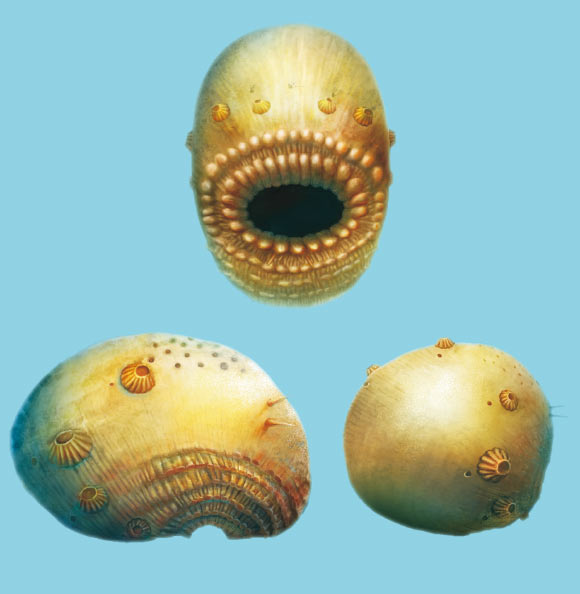Stop us if you've heard this one before, but life is a miracle. It really is. For billions of years, the universe was nothing but dust and gas and rocks and metal and fire and ice...until...
Cells. And amoebas. And worms. Fish. Amphibians. Dinosaurs. Rodents. Whales. Apes. And...us?
Yep, it's a crazy story to consider that creatures as complex as us came from beginnings as simple and small as cells. And now, thanks to newly discovered fossils in Shaanxi, China, the story is about to get even crazier.
Feast your eyes on our earliest ancestor: Señor Bag Body Crown Mouth.

"I've looked better..." A fossil of a flattened Saccorhytus coronarius. (Simon Conway Morris/University of Cambridge)
Feed me, please
You know, you might think that we made that name up. (Which, okay, we did, especially the "Señor" part.) But the creature's scientific name, Saccorhytus coronarius, (say SAK-oh-RYE-tus coh-roh-NAHR-ee-us) essentially translates to "bag creature with a crown shaped mouth". And with good reason.
This creature was basically just a tiny sack with a large opening that served as its mouth. The microscopic organism measured only about 1.2 mm (0.04 inches) and lived in water about 540 million years ago. This makes it our earliest known ancestor. It's like looking in a mirror, right?
The start of something good

Family photo album. Different angles of Saccorhytus coronarius fossils. (Simon Conway Morris/University of Cambridge)
Seriously though, if are you straining to see the family resemblance, we understand. We didn't really get it at first, either. But Saccorhytus coronarius is the first known deuterostome. This is a superphylum, or large category of living things, that includes *deep breath* amphibians, fish, sea stars, urchins, reptiles, birds, and, yep, mammals. And sure enough, the creature actually does share many traits, including a symmetrical (or same on both sides) body and four openings around the mouth which likely evolved into gills in the first fish.
All of this means that this ancient creature, whose fossil just looks like a black grain of sand to the naked eye, is your great great great great great great great great great great great great great great great...(don't worry, you can go make a sandwich or run to the bathroom, we'll be here a while)...great great great great great great great great great great great great great great great great great great great great great great great great great great great great great great great great great great great great great great great great great great great great great great great great great great great great great great great great great grandparent.
So sorry about that, Gramps. We just didn't recognize you there for a moment. You've barely aged a day!
 These illustrations shows how our earliest ancestor may looked as it swam the prehistoric seas. (Jian Han/Simon Conway Morris/University of Cambridge)
These illustrations shows how our earliest ancestor may looked as it swam the prehistoric seas. (Jian Han/Simon Conway Morris/University of Cambridge)










sooooooooooooo weird ❗ ❗ ❗ ❗ ❗ ❓ ❓ ❓ ❓ ❓ 😕 😕 😕 😕 😕 😐 😐 😐 😐 😐 😐 😐 😐 😐 😐 so their our great great great great (e.t.c) GRANDPARENTS!!!!!!!!!!!!!!!!!!!
no not at all there just fossils 😡
WHAT????????????????????????????????
That is SOOOOOOOOOOOOOOOOOOOO COOL!!!!!!!!!!!!!!!!!!!!!!!!!!!!!
I wonder what MY ancestor would look like.????